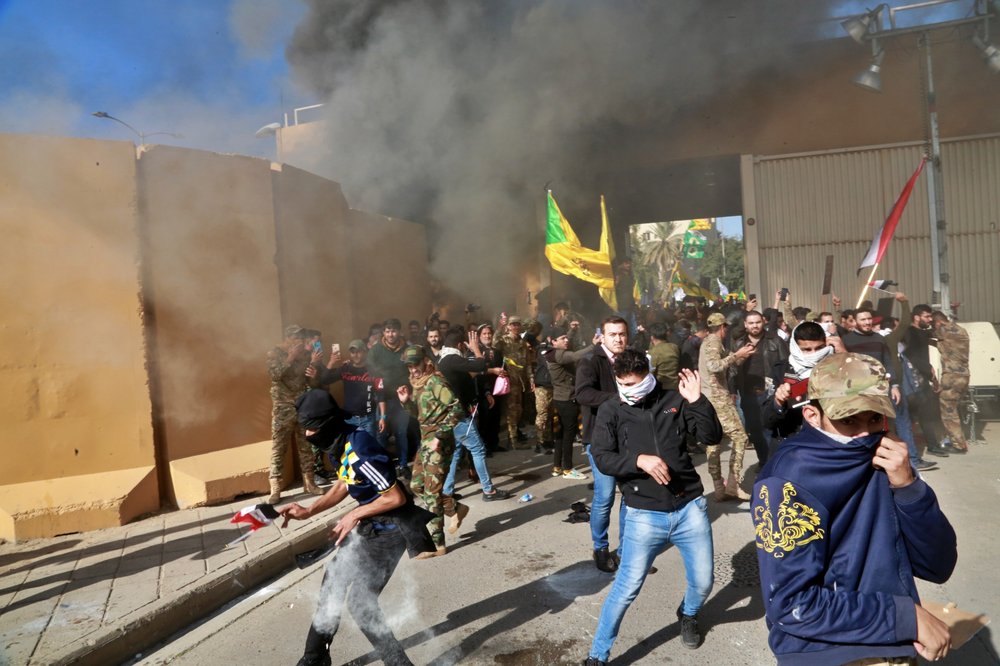
BAGHDAD (AP) — U.S. troops fired tear gas on Wednesday to disperse pro-Iran protesters who were gathered for a second day outside the American Embassy compound in Baghdad.
Dozens of Iran-allied militiamen and their supporters had camped out at the gates of the embassy in Baghdad overnight, a day after they broke into the compound, trashing a reception area and smashing windows in one of the worst attacks on a U.S. diplomatic mission in years.
The U.S. Marines guarding the embassy fired tear gas Wednesday as more crowds arrived and after the protesters lit a fire on the roof of the reception area. Smoke rose from the building.
The militiamen were protesting deadly U.S. airstrikes that targeted an Iran-backed militia over the weekend, killing 25 fighters. Those strikes were in response to a rocket attack on an Iraqi army base that killed a U.S. contractor.
The violence comes as Iran and its allies have faced unprecedented mass protests in recent months and after heavy U.S. sanctions on Iran that have cratered its economy and raised tensions across the region. In Iraq, the protesters have been angered at their own government’s corruption and economic mismanagement, as well as its close ties to Tehran.
President Donald Trump blamed Iran for the attack on the embassy and Defense Secretary Mark Esper later announced the immediate deployment of an infantry battalion of about 750 soldiers from the Army’s 82nd Airborne Division to the Middle East. He did not specify their destination, but a U.S. official familiar with the decision said they will go to Kuwait.
Iran has denied any involvement in the attack on the embassy. Foreign Ministry spokesman Abbas Mousavi was quoted by state media on Tuesday as warning the U.S. against any “miscalculation” in the worsening standoff.
Iran’s supreme leader, Ayatollah Ali Khamenei, criticized the U.S. airstrikes on the Iran-backed Iraqi militia on Sunday. He accused the U.S. of taking revenge on Iran for the defeat of the Islamic State group, which he said was an American creation. He condemned U.S. “wickedness,” according to the remarks carried by the semi-official ISNA news agency.
The U.S. and Iran have vied for influence over Iraq since the 2003 U.S.-led invasion that toppled Saddam Hussein. Iran has close ties to Iraq’s Shia majority and many of its major political factions, and its influence has steadily grown since then.
Iran helped to mobilize tens of thousands of mostly Shia militiamen to battle the Islamic State group when it stormed across northern and western Iraq in 2014 as the armed forces collapsed. In the subsequent campaign against the extremists, the U.S. and Iran both provided vital aid to Iraqi forces, who eventually declared victory in December 2017.
The pro-Iranian militias’ political influence in Iraq has risen in recent years, and their allies dominate the parliament and the government. That has made them the target of mass protests since October that are unrelated to the attack on the embassy.
The anti-government protesters have attacked Iranian diplomatic missions and the local headquarters of parties affiliated with the militias across southern Iraq. They have also set up a major protest camp in central Baghdad.
For weeks, the anti-government protesters have been trying to enter the Green Zone housing the government and the U.S. Embassy, but have been beaten back by security forces Hundreds of demonstrators have been killed in clashes with security forces.
The militiamen and their supporters, however, were able to quickly enter the Green Zone and mass in front of the embassy, with little if any resistance from authorities.
Reporting by Qassim Abdul-Zahra
Image: U.S. soldiers fire tear gas towards protesters who broke into the U.S. embassy compound, in Baghdad, Iraq, Tuesday, Dec. 31, 2019 (AP Photo/Khalid Mohammed)




